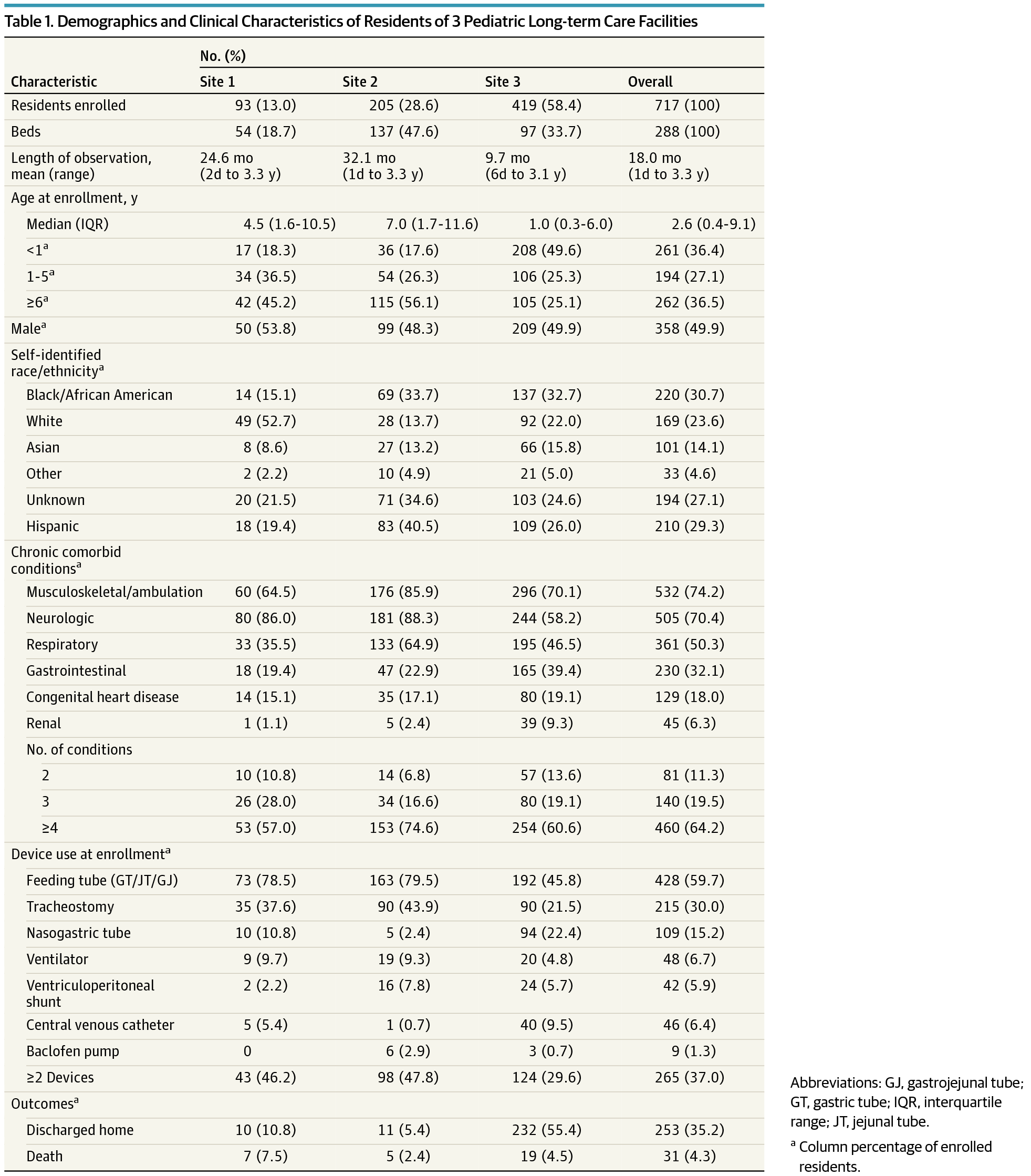当前位置:
X-MOL 学术
›
JAMA Pediatr.
›
论文详情
Our official English website, www.x-mol.net, welcomes your
feedback! (Note: you will need to create a separate account there.)
Incidence, Risks, and Types of Infections in Pediatric Long-term Care Facilities
JAMA Pediatrics ( IF 24.7 ) Pub Date : 2017-09-01 , DOI: 10.1001/jamapediatrics.2017.1482 Lisa Saiman 1 , Philip Maykowski 2 , Meghan Murray 3 , Bevin Cohen 3 , Natalie Neu 4 , Haomioa Jia 5 , Gordon Hutcheon 6 , Edwin Simpser 7 , Linda Mosiello 8 , Luis Alba 9 , Elaine Larson 5
JAMA Pediatrics ( IF 24.7 ) Pub Date : 2017-09-01 , DOI: 10.1001/jamapediatrics.2017.1482 Lisa Saiman 1 , Philip Maykowski 2 , Meghan Murray 3 , Bevin Cohen 3 , Natalie Neu 4 , Haomioa Jia 5 , Gordon Hutcheon 6 , Edwin Simpser 7 , Linda Mosiello 8 , Luis Alba 9 , Elaine Larson 5
Affiliation

|
Importance The population of infants, children, and adolescents cared for at pediatric long-term care facilities is increasing in complexity and size and thus consumes substantial health care resources. Infections are a significant cause of morbidity and mortality in this population, but few recent data describe their incidence and effects. Objectives To describe the types of infections diagnosed in residents of pediatric long-term care facilities, calculate infection rates, and identify risk factors for respiratory tract infections (RTIs). Design, Setting, and Participants This prospective cohort study, which was part of a larger trial called Keep It Clean for Kids, was conducted from September 1, 2012, to December 31, 2015, at 3 pediatric long-term care facilities in New York. Residents of the facilities who were 21 years or younger and either residents or admitted during the study period (n = 717) were enrolled in the study. Medical records were reviewed to identify infections diagnosed by site clinicians. Main Outcomes and Measures Incidence of infections, such as RTIs; skin and soft-tissue infections; chronic comorbid conditions, including neurologic and respiratory disorders; and device use, including gastrostomy tubes and tracheostomies, was determined. Risk factors for RTIs were assessed by generalized linear mixed method regression modeling. Results The 717 residents had a median (interquartile range) age at enrollment of 2.6 (0.4-9.1) years; 358 (49.9%) were male. Four hundred twenty-eight residents (59.7%) had feeding tubes and 215 (30.0%) had tracheostomies. Most chronic comorbid conditions were musculoskeletal or ambulation (532 residents [74.2%]), neurologic (505 [70.4%]), respiratory (361 [50.3%]), and gastrointestinal (230 [32.1%]) disorders, and 460 residents (64.2%) had 4 or more chronic comorbid conditions. Site clinicians diagnosed 2052 infections during the 3-year study period. Respiratory tract infections were most common and were diagnosed in 1291 residents (62.9%). The overall infection rate was 5.3 infections per 1000 resident-days, and RTI rates were 3.3 infections per 1000 resident-days. Overall infection rates and rates of RTI, skin and soft-tissue infection, urinary tract infection, and bloodstream infection varied among the 3 sites. In the multivariable model, younger age (incidence rate ratio [IRR], 1.05; 95% CI, 1.03-1.06), increased number of chronic comorbid conditions (IRR, 1.12; 95% CI, 1.06-1.19), and the use of feeding tubes (IRR, 1.34; 95% CI, 1.03-1.64) and tracheostomies (IRR, 1.40; 95% CI, 1.17-1.69) were associated with RTIs. Conclusions and Relevance In this study, RTIs were the most common infections diagnosed, but modifiable risk factors for RTIs were not identified. Future work should focus on optimizing infection prevention and control strategies to reduce infections, particularly RTIs, in the pediatric long-term care population.
中文翻译:

儿科长期护理机构感染的发生率、风险和类型
重要性 在儿科长期护理机构照顾的婴儿、儿童和青少年人口的复杂性和规模不断增加,因此消耗了大量的卫生保健资源。感染是该人群发病率和死亡率的重要原因,但最近的数据很少描述其发生率和影响。目的 描述儿科长期护理机构居民诊断出的感染类型,计算感染率,并确定呼吸道感染 (RTI) 的危险因素。设计、设置和参与者 这项前瞻性队列研究是一项名为 Keep It Clean for Kids 的大型试验的一部分,于 2012 年 9 月 1 日至 2015 年 12 月 31 日在纽约的 3 家儿科长期护理机构进行. 21 岁或以下的设施居民以及在研究期间居民或入院的居民(n = 717)参加了研究。审查医疗记录以确定现场临床医生诊断的感染。主要结果和措施 感染的发生率,例如 RTIs;皮肤和软组织感染;慢性合并症,包括神经系统和呼吸系统疾病;并确定了设备的使用,包括胃造口管和气管造口术。通过广义线性混合方法回归模型评估 RTI 的风险因素。结果 717 名居民在入组时的中位(四分位距)年龄为 2.6 (0.4-9.1) 岁;358 (49.9%) 名男性。428 名居民 (59.7%) 有饲管,215 名 (30.0%) 有气管造口术。大多数慢性合并症是肌肉骨骼或行走(532 名住院医师 [74.2%])、神经系统(505 [70.4%])、呼吸系统(361 [50.3%])和胃肠道(230 [32.1%])疾病,以及 460 名住院医师( 64.2%) 有 4 种或更多慢性合并症。在为期 3 年的研究期间,现场临床医生诊断出 2052 例感染。呼吸道感染是最常见的,在 1291 名居民(62.9%)中被诊断出来。总体感染率为每 1000 居民天 5.3 感染,RTI 率为每 1000 居民天 3.3 感染。3 个部位的总体感染率和 RTI、皮肤和软组织感染、尿路感染和血流感染的发生率各不相同。在多变量模型中,年龄较小(发病率比 [IRR],1.05;95% CI,1.03-1.06),慢性合并症的数量增加(IRR,1. 12; 95% CI, 1.06-1.19)、使用饲管 (IRR, 1.34; 95% CI, 1.03-1.64) 和气管切开术 (IRR, 1.40; 95% CI, 1.17-1.69) 与 RTIs 相关。结论和相关性 在本研究中,RTIs 是最常见的感染诊断,但未确定 RTIs 的可改变风险因素。未来的工作应侧重于优化感染预防和控制策略,以减少儿科长期护理人群中的感染,尤其是 RTIs。
更新日期:2017-09-01
中文翻译:

儿科长期护理机构感染的发生率、风险和类型
重要性 在儿科长期护理机构照顾的婴儿、儿童和青少年人口的复杂性和规模不断增加,因此消耗了大量的卫生保健资源。感染是该人群发病率和死亡率的重要原因,但最近的数据很少描述其发生率和影响。目的 描述儿科长期护理机构居民诊断出的感染类型,计算感染率,并确定呼吸道感染 (RTI) 的危险因素。设计、设置和参与者 这项前瞻性队列研究是一项名为 Keep It Clean for Kids 的大型试验的一部分,于 2012 年 9 月 1 日至 2015 年 12 月 31 日在纽约的 3 家儿科长期护理机构进行. 21 岁或以下的设施居民以及在研究期间居民或入院的居民(n = 717)参加了研究。审查医疗记录以确定现场临床医生诊断的感染。主要结果和措施 感染的发生率,例如 RTIs;皮肤和软组织感染;慢性合并症,包括神经系统和呼吸系统疾病;并确定了设备的使用,包括胃造口管和气管造口术。通过广义线性混合方法回归模型评估 RTI 的风险因素。结果 717 名居民在入组时的中位(四分位距)年龄为 2.6 (0.4-9.1) 岁;358 (49.9%) 名男性。428 名居民 (59.7%) 有饲管,215 名 (30.0%) 有气管造口术。大多数慢性合并症是肌肉骨骼或行走(532 名住院医师 [74.2%])、神经系统(505 [70.4%])、呼吸系统(361 [50.3%])和胃肠道(230 [32.1%])疾病,以及 460 名住院医师( 64.2%) 有 4 种或更多慢性合并症。在为期 3 年的研究期间,现场临床医生诊断出 2052 例感染。呼吸道感染是最常见的,在 1291 名居民(62.9%)中被诊断出来。总体感染率为每 1000 居民天 5.3 感染,RTI 率为每 1000 居民天 3.3 感染。3 个部位的总体感染率和 RTI、皮肤和软组织感染、尿路感染和血流感染的发生率各不相同。在多变量模型中,年龄较小(发病率比 [IRR],1.05;95% CI,1.03-1.06),慢性合并症的数量增加(IRR,1. 12; 95% CI, 1.06-1.19)、使用饲管 (IRR, 1.34; 95% CI, 1.03-1.64) 和气管切开术 (IRR, 1.40; 95% CI, 1.17-1.69) 与 RTIs 相关。结论和相关性 在本研究中,RTIs 是最常见的感染诊断,但未确定 RTIs 的可改变风险因素。未来的工作应侧重于优化感染预防和控制策略,以减少儿科长期护理人群中的感染,尤其是 RTIs。











































 京公网安备 11010802027423号
京公网安备 11010802027423号